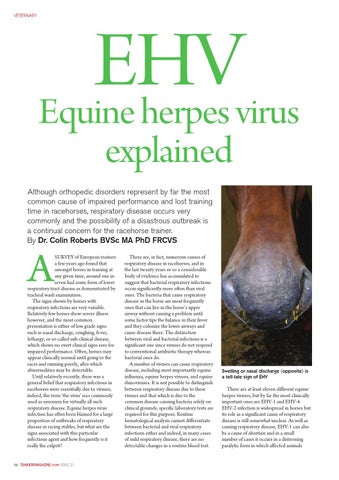EHV NA ISSUE 21_Jerkins feature.qxd 20/07/2011 12:28 Page 1
VETERINARY
EHV Equine herpes virus explained Although orthopedic disorders represent by far the most common cause of impaired performance and lost training time in racehorses, respiratory disease occurs very commonly and the possibility of a disastrous outbreak is a continual concern for the racehorse trainer. By Dr. Colin Roberts BVSc MA PhD FRCVS
A
SURVEY of European trainers a few years ago found that amongst horses in training at any given time, around one in seven had some form of lower respiratory tract disease as demonstrated by tracheal wash examination. The signs shown by horses with respiratory infections are very variable. Relatively few horses show severe illness however, and the most common presentation is either of low grade signs such as nasal discharge, coughing, fever, lethargy, or so-called sub-clinical disease, which shows no overt clinical signs save for impaired performance. Often, horses may appear clinically normal until going to the races and running poorly, after which abnormalities may be detectable. Until relatively recently, there was a general belief that respiratory infections in racehorses were essentially due to viruses; indeed, the term ‘the virus’ was commonly used as synonym for virtually all such respiratory disease. Equine herpes virus infection has often been blamed for a large proportion of outbreaks of respiratory disease in racing stables, but what are the signs associated with this particular infectious agent and how frequently is it really the culprit?
66 TRAINERMAGAZINE.com ISSUE 21
There are, in fact, numerous causes of respiratory disease in racehorses, and in the last twenty years or so a considerable body of evidence has accumulated to suggest that bacterial respiratory infections occur significantly more often than viral ones. The bacteria that cause respiratory disease in the horse are most frequently ones that can live in the horse’s upper airway without causing a problem until some factor tips the balance in their favor and they colonize the lower airways and cause disease there. The distinction between viral and bacterial infections is a significant one since viruses do not respond to conventional antibiotic therapy whereas bacterial ones do. A number of viruses can cause respiratory disease, including most importantly equine influenza, equine herpes viruses, and equine rhinoviruses. It is not possible to distinguish between respiratory disease due to these viruses and that which is due to the common disease-causing bacteria solely on clinical grounds; specific laboratory tests are required for this purpose. Routine hematological analysis cannot differentiate between bacterial and viral respiratory infections either and indeed, in many cases of mild respiratory disease, there are no detectable changes in a routine blood test.
Swelling or nasal discharge (opposite) is a tell-tale sign of EHV
There are at least eleven different equine herpes viruses, but by far the most clinically important ones are EHV-1 and EHV-4. EHV-2 infection is widespread in horses but its role as a significant cause of respiratory disease is still somewhat unclear. As well as causing respiratory disease, EHV-1 can also be a cause of abortion and in a small number of cases it occurs in a distressing paralytic form in which affected animals
